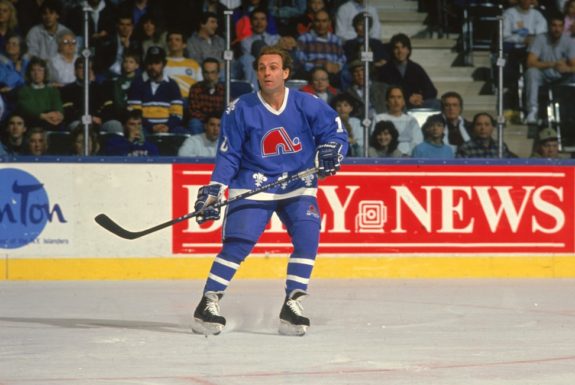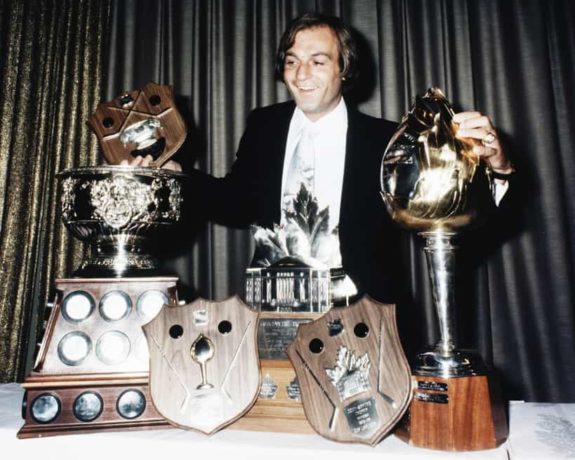Guy Lafleur was 38 years old when he signed as a free agent with the Quebec Nordiques on July 14, 1989. The man affectionately known as “The Flower” was already a Hockey Hall of Famer before he ever donned the blue and white fleur-de-lis, having been inducted the year prior.
In retrospect, the 1989-90 Nordiques were an oddity of sorts. Seven different goaltenders suited up for them during the season – still an NHL record, though since tied – including longtime Soviet standout Sergei Mylnikov. Two eventual Hall of Famers were traded away before season’s end, while a sophomore Joe Sakic would record the first 100-point season of the six that he achieved in his NHL career. Another seven Nordiques eclipsed the 100-PIM plateau as well – what they lacked in the wins column was made up for in the box.

For Lafleur, the season was a bit of a last hurrah. While he would still play one more go-round with the Nordiques afterward, 1989-90 was the last bit of flash where we saw Lafleur score at a level that was reminiscent of his greatest years in Montreal. On a Nordiques team that finished dead last in the NHL with him, Le Démon Blond was a rare bright spot.
THW takes a look back at Lafleur’s second to last season, and why it is a one for the ages.
Stardom Long Beforehand
We will not spend too much on Lafleur’s time with the Canadiens, but it is obviously relevant to his legendary persona. Drafted with the first overall selection of the 1971 Draft, the native of Thurso, Quebec, Canada became the face of hockey’s most dominant franchise for the majority of the 1970s.
Lafleur would proceed to earn six straight NHL First All-Star Team selections beginning in 1974-75. He won three straight Art Ross Trophies (1976, 1977, 1978) as the league’s top scorer, two Hart Memorial Trophies (1977, 1978) as its Most Valuable Player, three Lester B. Pearson Awards (1976, 1977, 1978) as the MVP as voted by his peers, and one Conn Smythe Trophy (1977) as the MVP of the NHL playoffs.
When he initially retired from the Canadiens during the 1984-85 season, Lafleur had scored 518 goals, 728 assists, and 1,246 points in only 961 regular season games. Those totals were accomplished during the process of him scoring 50 or more goals in a season on six different occasions. In each of his 13 full seasons in Montreal, he never scored less than 21 goals in a campaign.
Lafleur won five Stanley Cups with the Canadiens and was quintessential in each one of them. Few Montreal players have ever been more revered than he was. The only player who tops Lafleur in that regard would be Maurice “The Rocket” Richard, and even that is not a given.
Lafleur’s Comeback
Having been away from the NHL for three full seasons, he made a comeback during the 1988-89 season. Lafleur joined the New York Rangers, where he was teammates (briefly) with legendary players Marcel Dionne and Brian Leetch.
Sign up for our NHL History Substack newsletter
Lafleur would suit up in 67 games for the “Blueshirts”, and would proceed to score 18 goals and 27 assists for 45 points after coming out of retirement. While certainly not prolific numbers, the totals demonstrated that Lafleur was still capable of playing in the NHL even as he approached the age of 40.
His 18 goals were eighth-most on the Rangers that season, while his 45 points placed him eighth for team scoring as well. Lafleur played in all four Rangers’ postseason games as the team got swept by the Pittsburgh Penguins. On Apr. 6, 1989, Lafleur scored his 58th and final career playoff goal as he beat Penguins goalie Tom Barrasso in the first period of Game Two.
A decent first season offensively in New York while compiling only 12 PIMs, Lafleur finished 10th in NHL voting for the Lady Byng Trophy in recognition of his gentlemanly play.
Signing With the Nordiques
Intending to finish his career back in Quebec, Lafleur signed as a free agent with the Nordiques during the summer following his lone season as a Ranger. Grandfathered in from his younger playing days, he was also one of only a handful of helmetless players remaining in the NHL as the league welcomed itself into the 1990s.
Don’t Miss Our ‘One for the Ages’ Collection
In addition to returning closer to home, Lafleur also had an opportunity to join three of hockey’s finest in Quebec – Sakic, Peter Stastny, and Michel Goulet. For five seasons in the early-1980s, Stastny and Goulet were the determined rivals of Lafleur and the Canadiens. As much as “Guy” was the face of Montreal, it was Stastny and Goulet who were the face of the Nordiques. Now “The Flower” had the opportunity to skate alongside them, at least initially.
Despite having all four of those eventual Hall of Famers, the 1989-90 Quebec Nordiques were abysmal. Their record of 12-61-7 was the worst in their 16-year NHL existence. Likewise, their 407 goals given up by their seven goaltenders was also a franchise-worst.
Things were bad enough that the Nordiques would end up trading away their two cornerstones just a day apart. Goulet, Kevin St. Jacques, and goaltender Greg Millen would be traded to the Chicago Blackhawks on Mar. 5, 1990 in exchange for Mario Doyon, Everett Sanipass and Dan Vincelette. The very next day, Stastny would be shipped to the New Jersey Devils for Craig Wolanin and future considerations.
Forty-nine different players would don the Nordiques jersey in 1989-90. Only one of them would score more than 24 goals, and only two of them finished the season on the positive side of plus/minus (namely because they only played 13 and six games respectively for Quebec).
Lafleur’s Success in 1989-90
Alongside Sakic’s 100-point performance (39-63-102), Lafleur was the only other Nordique – who wasn’t traded away – to make a positive difference for the team. “The Flower” demonstrated shades of his younger self by being nearly a point-per-game player. He would score 12 goals and 22 assists for 34 points in 39 games.
Though he played in less than half of Quebec’s regular season games, Lafleur’s 34 points ended being the third highest total after Stastny and Goulet were traded. His 12 goals were fourth most on the team.
Despite the unexceptional amount of games, Lafleur’s solid performance did not go unnoticed. He would again earn consideration in voting for the Lady Byng, ranking 18th overall in the ballots. For a player to appear in so few games, 18th is pretty good.
Furthermore, Lafleur’s frequency for scoring showed that he could still play and still be relevant. As we will demonstrate, he was also able to connect well with the young Sakic.
We take a look now at some of the finer moments from “Guy’s” 1989-90 NHL season:
Oct. 5, 1989:
In his very first game as a Quebec Nordique, Lafleur would score his first goal with the team. What is especially interest about this game is that another tremendous right winger – the Sabres’ Alexander Mogilny – scored his first career NHL goal just 20 seconds into the game.
Lafleur would strike back for the Nordiques just over seven minutes later when he beat Buffalo goalie Daren Puppa. Fellow Nordiques Claude Loiselle and Marc Fortier earned the assists on “The Flower’s” first.
The two squads would trade goals the rest of the way, with Goulet and Sakic scoring their firsts of the season as well. With two scores from Sabres’ tough-guy Mike Hartman, Buffalo would take the 4-3 win.
Oct. 7, 1989:
Lafleur would follow up his game in Buffalo with a second goal and an assist just two days later. Quebec would earn their first victory of the season by downing their Adams Division rival Boston Bruins by a score of 4-1.

Nursing a 2-1 lead in the second period, Lafleur and Stastny combined to set up Iiro Jarvi to add the ever-important insurance goal. Less than 10 minutes into the third period, the Finnish Jarvi returned the favor when he and Mario Marois earned the helpers on Lafleur’s tally – a power play goal that beat Boston goalie Andy Moog.
Oct. 8, 1989:
Lafleur would record another two points the very next day. Facing the Hartford Whalers in Quebec, the Nordiques would play to a wild 9-6 loss despite starting off with a 3-0 lead.
After Sakic and Stastny both scored, Lafleur and Stastny combined to set up Greg Adams for the only goal he ever tallied as a Nordique. Before the first period would even close, the Whalers received scores from Mikael Andersson, Ron Francis and Scott Young to make it a 3-3 score.
The Whalers would score four more straight after that to take a commanding 7-3 lead. The Nordiques endeavored to rally, as Sakic and Lafleur would score their team’s fifth and sixth. The comeback, however, would fall short.
Despite the loss, Lafleur had generated five points in only three games.
Oct. 21, 1989:
Hosting the Minnesota North Stars, Lafleur turned out a 3-point night to lead the Nordiques to a decisive 7-2 victory.
Fortier would open the game’s scoring at the 2:30 mark with assists from Lafleur and Michel Petit. The Nordiques would proceed to score three more in a row with tallies from Loiselle, Jeff Brown and Stastny.
Mike Modano would get the North Stars on the board midway through the second, but it would be for not. Less than a minute after his score, Lafleur and Brown set up Stastny for another tally.
With Modano in the box for slashing, Stastny and Lafleur would pick up assists on a Brown’s power play goal at 8:20 of the third period. The Nordiques would skate away with the victory, and Lafleur would have three helpers on the night.
Dec. 23, 1989:
Lafleur would generate another 3-assist night a few days before Christmas. The Nordiques hosted the Sabres and fell short in a tight 6-5 loss in Le Colisée de Québec.
Goulet scored the first goal of the game less than five minutes in from Brian Lawton and Lafleur. The Sabres would then respond with four straight goals to take a commanding 4-1 lead. Kudos should be given to the Nordiques, who would push for the comeback with Lafleur, Lawton and Goulet leading the charge.
Quebec narrowed the lead to 4-2 when Lawton beat Clint Malarchuk on the power play from Lafleur and Petit. Buffalo responded with a Christian Ruuttu goal only two minutes later. Lawton and Sakic would score two more power play goals to make it 5-4, with Lafleur getting the assist on Sakic’s marker to earn his third helper.
Buffalo’s Rick Vaive scored what would be the game-winner with a power play score of his own at 5:32 of the third. The Sabres would hold on, despite Petit scoring shortly thereafter to make it 6-5.
Jan. 13 and 16, 1990:
It would be three points in two games for “The Flower” as the Nordiques would face the New Jersey Devils first, followed by a trip out west to Winnipeg.
Hosting the Devils in Quebec, Lafleur would capitalize on the power play with New Jersey’s Randy Velischek in the box for holding. The score was Lafleur’s 11th of the season as Goulet and Stastny earned the assists. The two teams would go back and forth in goal scoring, but the Devils would squeeze out the 5-4 win.
Three days later, the Nordiques would earn some redemption as they fired their way to an 8-6 win over the Jets. Winnipeg’s Daniel “Bandit” Berthiaume gave up seven goals, while Quebec’s eighth score was an empty-netter.
En route to victory, Lafleur and Lawton set up Tony McKegney at 10:05 of the first for Quebec’s first of the game. Lafleur scored his 12th and final goal of the season when he knotted the score 3-3 from Curtis Leschyshyn and Jeff Jackson.
Mar. 27, 1990:
For the third time in 1989-90, Lafleur would put forth a 3-assist game. With the New York Rangers playing in Quebec, “The Flower” would be one of the few bright spots for his team on this particular date. The Nordiques would suffer a 7-4 loss to the “Blueshirts” while most of their team fell flat-footed.
Lafleur, for his efforts, set up two goals from “Burnaby Joe” and one from Petit. He would also be one of only four Nordiques to finish the game as a plus player.
Wrapping up His NHL Career
Lafleur would play one final NHL season following 1989-90. He reportedly turned down a $1 million offer to sign with the Los Angeles Kings so that he could finish out his career in Quebec, and ultimately re-upped with the Nordiques.
A fuller, second campaign with the team seemed to finally show his age. Lafleur suited up for 59 games while Quebec again finished in last place with a mere 46 points (16-50-14). At 39 years old, the team’s elder statesman generated 12 goals and 16 assists for 28 points. Lafleur’s 12 goals were still good enough for sixth place on the roster.
That summer, the Minnesota North Stars would take part in the 1991 NHL Expansion Draft in order to restock their roster, while the newcomer San Jose Sharks built their own. Lafleur was selected by Minnesota with the 20th and final pick of the draft. Rather than play another season, he opted to retire for a second and final time.

When all was said and done, Lafleur played 98 games in a Nordiques uniform. For a player who was nearing the age of 40, he actually performed quite well – 24 goals, 38 assists and 62 points in that time.
Those numbers would be the proverbial icing on the cake for “The Flower”. Lafleur ended his NHL career having scored totals of 560 goals, 793 assists, and 1,353 points in 1,127 regular season games.
While he will be best remembered as one of the premier Montreal Canadiens to ever wear bleu, blanc et rouge – perhaps even the greatest – it is important to not overlook Lafleur’s swan song. He still had enough gas in the tank to work some magic in 1989-90 – a one for the ages season for “The Flower”, indeed.
